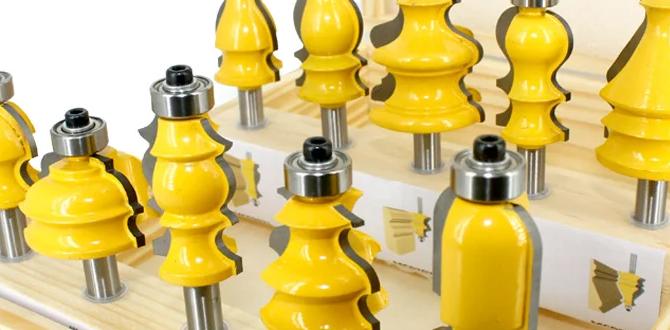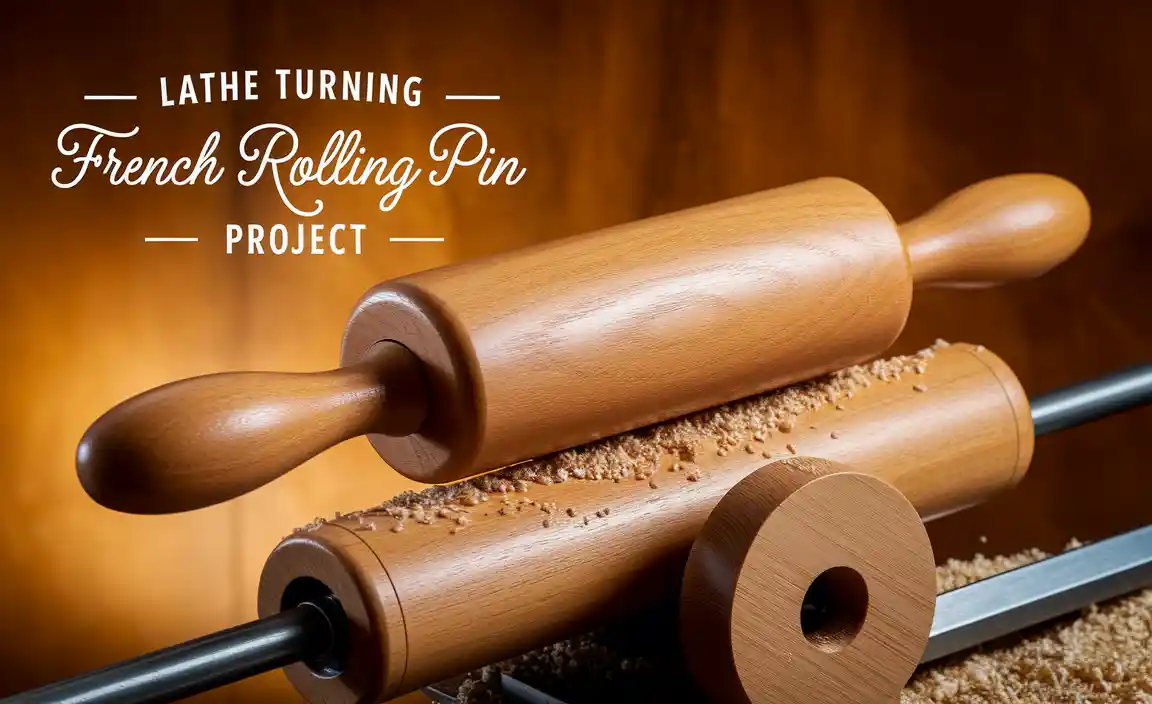TIAlN Ball Nose End Mill 35 Degree: Essential for Carbon Steel Milling
A 35-degree TIAlN ball nose end mill is a fantastic tool for milling carbon steel! Its special coating and shape help it cut cleanly and efficiently, making it ideal for creating complex shapes and smooth finishes in harder materials without overheating. Using the right tool saves you time and effort, leading to better results.
Carbon steel can be tricky to machine. It’s tough and can wear down tools quickly, leading to frustration and poor cut quality. But what if I told you there’s a specific type of end mill that makes milling carbon steel much easier and more effective? We’re going to dive into the world of the TIAlN ball nose end mill with a 35-degree helix angle. This tool is a game-changer for many machining tasks, especially when you need to create smooth, curved surfaces or intricate 3D profiles in materials like carbon steel. Don’t worry if you’re new to this; we’ll break it down step-by-step so you can confidently use this essential tool to get great results in your workshop.
What Exactly is a TIAlN Ball Nose End Mill with a 35-Degree Helix Angle?
Let’s get to know our star player! A ball nose end mill is a type of cutting tool used in milling machines. Its cutting tip is shaped like a ball, meaning it has a perfectly rounded end. This shape is perfect for creating contoured surfaces, fillets, and for plunging straight down into material like a drill.
The Bits and Pieces:
-
End Mill: This is the tool that spins and cuts the material.
-
Ball Nose: The tip of the end mill is a perfect hemisphere. This allows for smooth, curved cuts and profiles.
-
TIAlN Coating: This is a super-thin, hard coating applied to the end mill. TIAlN stands for Titanium Aluminum Nitride. It’s typically a dark purple or bronze color. This coating is incredibly tough and heat-resistant. It protects the cutting edges, allowing the tool to cut faster and last longer, especially in harder materials.
-
35-Degree Helix Angle: The helical flutes (the spirals on the cutting tool) are angled at 35 degrees. This angle affects how the tool chips away at the material. A 35-degree angle is often a good compromise for many materials, offering good chip evacuation and a relatively smooth finish, especially compared to tools with very steep or very shallow helix angles. It’s versatile and works well for a range of operations on steels.
Why is this Combo Great for Carbon Steel?
Carbon steel is harder and tougher than materials like aluminum or plastics. It generates more heat and friction when cut. The TIAlN coating is the hero here. It acts like a shield, preventing the high heat from damaging the cutting edge of the end mill. This means the tool stays sharper for longer, allowing you to make more cuts before needing to sharpen or replace it. The ball nose shape makes it perfect for creating the smooth, sweeping curves often found in molds and dies, which are commonly made from carbon steel. The 35-degree helix angle helps manage the tougher chips produced by carbon steel, preventing them from welding onto the cutter.
The Problem with the Wrong Tool for Carbon Steel
Imagine trying to carve a detailed sculpture with a butter knife. That’s kind of what happens when you try to mill carbon steel with a general-purpose end mill not designed for it. It doesn’t go well.
-
Premature Tool Wear: Standard end mills, especially those without special coatings, will dull very quickly when cutting carbon steel. The hard material wears away the cutting edges fast.
-
Overheating: Carbon steel generates a lot of heat during machining. Without good heat resistance, the end mill can overheat, causing the cutting edges to soften and break down. This can also lead to a phenomenon called “built-up edge” (BUE), where chips fuse to the cutter, ruining the surface finish.
-
Poor Surface Finish: A dull or overheated tool will tear at the material instead of cutting it cleanly. This leaves you with a rough, unsatisfactory surface that requires a lot of extra finishing work, if it’s even salvageable.
-
Risk of Tool Breakage: When a tool is struggling, dull, or clogged with chips, it puts extra stress on the end mill. This dramatically increases the chance of the tool snapping off inside your workpiece, which can damage your part and your machine.
-
Slower Machining Times: If your tool is dull or you’re afraid of breaking it, you’ll have to slow down your cutting speeds and feeds. This means longer machining times, which isn’t efficient.
Using the right tool, like a TIAlN ball nose end mill with a 35-degree helix, dramatically reduces these problems, making your machining experience smoother and your results better.
Why the TIAlN Ball Nose End Mill is Your Carbon Steel Friend
Let’s talk about why this specific end mill design is so good for carbon steel. It’s a combination of its shape and its special coating.
Benefits of the TIAlN Coating
-
Extreme Hardness: TIAlN is one of the hardest coatings available for cutting tools. This hardness allows it to resist wear and abrasion from tough materials like carbon steel.
-
High Heat Resistance: This is crucial for carbon steel. The TIAlN coating can withstand extremely high temperatures (up to 800°C or 1470°F in some cases), preventing the end mill from softening and losing its cutting ability at the point of contact. This allows for higher cutting speeds.
-
Reduced Friction: The coating creates a slicker surface, which reduces friction between the tool and the workpiece. Less friction means less heat generated and easier chip evacuation.
-
Extended Tool Life: All these benefits—hardness, heat resistance, and reduced friction—add up to a significantly longer lifespan for your end mill when cutting carbon steel. You get more parts out of a single tool.
-
Improved Surface Finish: Because the tool stays sharp and cuts cleanly, it leaves a much smoother finish on the material. This means less post-machining cleanup.
Advantages of the Ball Nose Shape
-
3D Contouring and Sculpting: The perfectly rounded tip is essential for creating complex 3D shapes, curved surfaces, and fillets. This is a common requirement in mold making and custom part design.
-
Achieving Smooth Radii: When you need a specific internal or external radius, a ball nose end mill is the ideal tool. You can machine a radius directly by stepping over with the center of the ball, or by using the side cutting edge to create a smooth transition.
-
Efficient Material Removal in Pockets: For deep pockets where you need to remove material from the bottom, the ball shape allows for smooth engagement without digging into the sides excessively in areas that don’t need a sharp corner.
-
Plunge Cutting Capability: While not its primary function, a ball nose end mill can be used for plunging straight into material, similar to a drill, though specialized tools are better for deep drilling.
The Role of the 35-Degree Helix Angle
While you’ll find end mills with helix angles like 30, 45, or even 60 degrees, 35 degrees is a very common and versatile choice, especially for steels.
-
Good Chip Evacuation: The angle of the flutes helps to curl and eject chips away from the cutting zone. For tougher materials like carbon steel, efficient chip removal is vital to prevent re-cutting chips, which generates heat and dulls the tool. A 35-degree angle offers a good balance for this.
-
Reduced Cutting Forces: A moderate helix angle generally results in lower axial and radial cutting forces compared to tools with very steep or very shallow helix angles. This can lead to a more stable cut and less vibration, important for preventing tool breakage.
-
Smooth Surface Finish: The 35-degree angle, when combined with the ball nose and TIAlN coating, contributes to a smooth, consistent surface finish on carbon steel. It avoids the chatter sometimes associated with very steep helix angles or the potential for poor chip handling of an extremely low helix.
This combination makes the TIAlN ball nose end mill with a 35-degree helix angle an excellent, go-to tool for anyone working with carbon steel, whether for intricate designs or general contouring.
When is a TIAlN Ball Nose End Mill 35 Degree the Best Choice?
This specialized tool isn’t for every single job, but it shines in specific scenarios, especially when dealing with carbon steel.
Ideal Applications Include:
-
3D Contouring and Sculpting: If you need to create flowing, organic shapes or detailed 3D models, the ball nose is indispensable. Imagine machining a prototype part for a car or an intricate artistic sculpture.
-
Mold and Die Making: Carbon steel is frequently used for molds and dies. This end mill is perfect for creating the curved cavities and precise features needed in these applications. For example, shaping the interior of an injection mold for plastic parts.
-
Radiused Pockets and Slots: When you need a smooth corner radius inside a pocket or slot, the ball nose end mill is the primary tool for the job. This is common in mechanical designs for stress reduction or to accommodate other components.
-
Finishing Passes: After roughing out a shape with a less precise tool, a ball nose end mill can be used for a finishing pass to achieve a smooth, highly accurate surface. This is where the “ball” part really shines for detail.
-
Engraving and Texturing: For detailed work like engraving letters or creating textured surfaces on carbon steel parts, the fine control offered by a ball nose end mill is extremely valuable.
-
Machining Harder Steels: While great for general carbon steel, its real strength is in its ability to handle medium to high-carbon steels, tool steels, and other alloys that typically cause standard end mills to fail quickly.
When to Consider Other Tools:
-
Roughing Deep Slots (Very Shallow Diameters): For very deep, narrow slots, a slotting end mill or a square end mill with a smaller corner radius and a different coating might be more efficient for bulk material removal.
-
Face Milling: A face mill is designed for creating flat surfaces quickly. A ball nose end mill is not suitable for this.
-
Drilling: While ball nose end mills can plunge, dedicated drill bits or center drills are far more efficient and accurate for creating holes.
-
Very Soft Materials: For aluminum or plastics, a ZrN (Zirconium Nitride) or TiCN (Titanium Carbon Nitride) coating, or even an uncoated tool, might perform better or be more cost-effective. The extreme heat resistance of TIAlN is often overkill.
The TIAlN ball nose end mill shines when you need precision, smooth finishes, and durability when working with the challenges that carbon steel presents.
Setting Up for Success: Machining Parameters
Getting the most out of your TIAlN ball nose end mill for carbon steel involves setting the right cutting parameters. These are starting points, and you may need to adjust them based on your specific machine, workpiece rigidity, and the exact grade of carbon steel. Always prioritize safety!
Key Machining Parameters:
Cutting Speed (Surface Speed)
This is the speed at which the cutting edge is moving through the material. It’s usually measured in Surface Feet per Minute (SFM) or meters per minute (m/min). For TIAlN coated end mills cutting carbon steel, a good starting range is often between 200-350 SFM (approximately 60-105 m/min).
Feed Rate
This is how fast the tool advances into or along the material. It’s often expressed as Inches per Tooth (IPT) or millimeters per tooth (mm/tooth). This value depends heavily on the diameter of your end mill and the number of flutes. A common starting point for a 1/4″ (6mm) diameter, 4-flute end mill cutting carbon steel might be around 0.0015 – 0.003 IPT (0.04 – 0.08 mm/tooth).
Depth of Cut (Ap and Ae)
Axial Depth of Cut (Ap): How deep the tool cuts into the material along its axis. For finishing passes with a ball nose end mill, you’ll use a very shallow Ap, often just 0.010″ – 0.020″ (0.25 – 0.50 mm) or even less for a mirror finish. For roughing, you can go deeper, but always consider the rigidity of your setup.
Radial Depth of Cut (Ae): How far the tool engages the material across its diameter. For profiling and contouring, this can range from 20% to 50% of the tool diameter (0.2D to 0.5D). For trochoidal milling (more on that later), Ae is kept very small, typically 5-10% of the tool diameter.
Spindle Speed (RPM)
This is what you will set on your milling machine. You calculate it from the cutting speed and the tool diameter.
The formula is:
RPM = (Cutting Speed [SFM] 12) / (π Tool Diameter [inches])
Or in metric:
RPM = (Cutting Speed [m/min] 1000) / (π Tool Diameter [mm])
Let’s calculate an example: If you want to use a 1/2″ diameter TIAlN ball nose end mill at 250 SFM in carbon steel:
RPM = (250 SFM 12) / (3.14159 0.5 inches) = 3000 / 1.5708 = approximately 1910 RPM.
Coolant/Lubrication
Machining carbon steel generates significant heat. Using a cutting fluid is almost always recommended. It cools the cutting zone, lubricates the cut, and helps wash away chips. Flood coolant, mist coolant, or a good quality cutting paste/oil can be used. For tough steels, a good flood coolant system is often best. You can find resources on cutting fluids from organizations like The Association for Manufacturing Technology (AMT).
Important Considerations for Carbon Steel:
-
Rigidity is Key: Ensure your workpiece is clamped very securely, and your machine setup is as rigid as possible. Any flex can lead to chatter and tool breakage.
-
Chip Thinning: This is an advanced technique where you adjust the feed rate to control the chip load. By using a smaller radial depth of cut (Ae) and a higher feed rate per tooth, you create thinner chips that are easier to evacuate. This is often used in combination with higher spindle speeds.
-
Start Conservatively: Always begin with the lower end of recommended speeds and feeds, and gradually increase them while listening to the machine and observing the chips. If you hear chatter or see burning, back off.
-
Tool Path Strategy: For complex 3D shapes, the tool path generated by your CAM software is critical. Ensure it’s optimized for the ball nose end mill.






